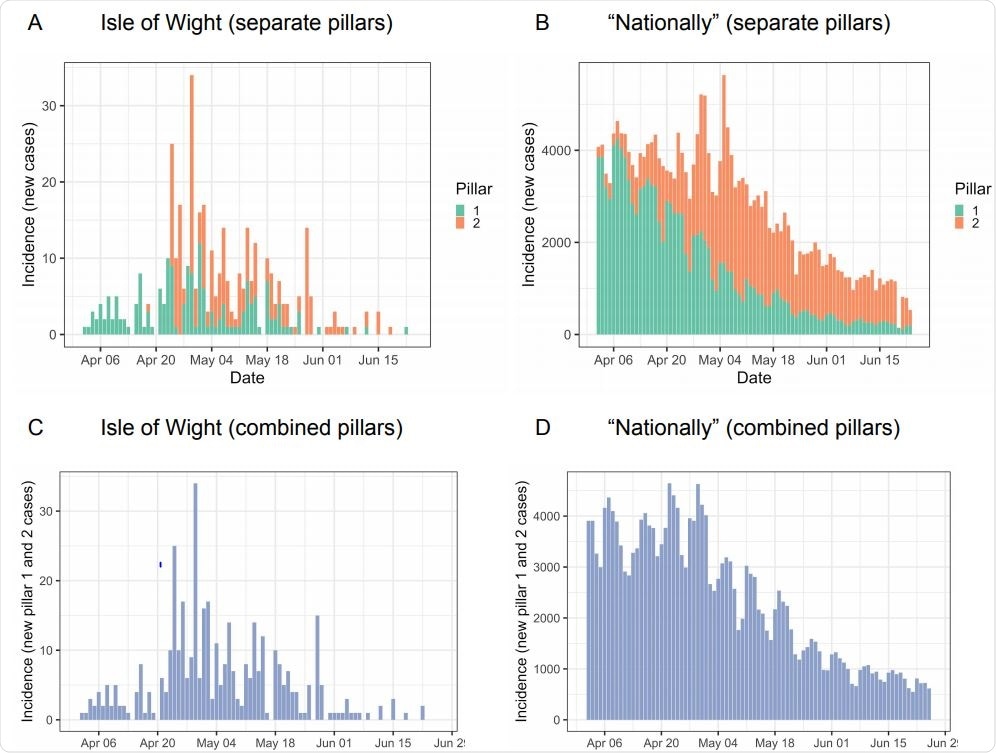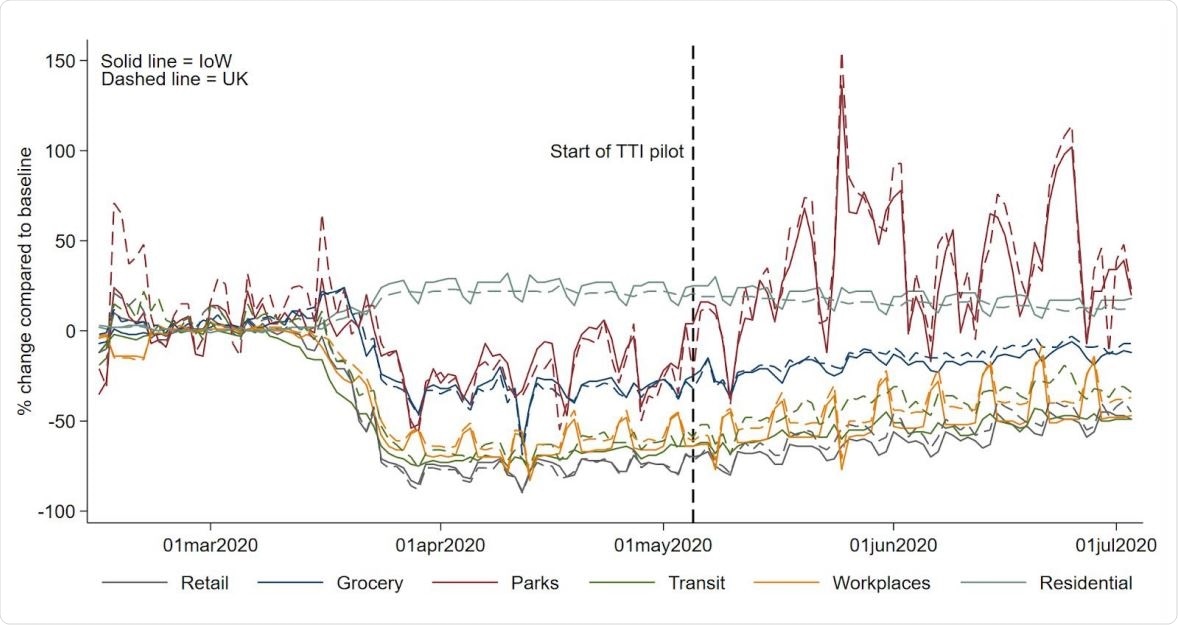Researchers in the UK report that the incidence of new coronavirus disease 2019 (COVID-19) cases fell in the Isle of Wight following the launch of a new “Test, Trace, Isolate (TTI)” program on May 5th that included the option of using an NHS Smartphone app.
Unlike the rest of the UK, which also saw the introduction of the program in May, the Isle of Wight program included Version 1 of the NHS Smartphone contact tracing app.
Christophe Fraser (University of Oxford) and colleagues report that the COVID-19 incidence and reproductive number significantly decreased immediately after the program was launched. The epidemic on the Isle of Wight was more effectively controlled than it was among most other Upper Tier Local Authorities (UTTLs) across England.
“The findings highlight the need for further research to determine the causes of this reduction, as these might translate into local and national non-pharmaceutical intervention strategies in the period before treatments or vaccinations become available,” said Fraser and colleagues.
A pre-print version of the paper is available in the server medRxiv*, while the article undergoes per review.

Daily incidence (A) on the Isle of Wight and (B) “nationally” (England for Pillar 1, UK except Wales for Pillar 2). (C) and (D) use the newly-released “combined” pillars data where Pillar 2 has been deduplicated. Each of these provides only a rough approximation of the true incidence because cases are recorded by the date the specimen was taken, not the time the individual became infected, and tests are expected to be performed at different stages of infection between the two pillars.

 This news article was a review of a preliminary scientific report that had not undergone peer-review at the time of publication. Since its initial publication, the scientific report has now been peer reviewed and accepted for publication in a Scientific Journal. Links to the preliminary and peer-reviewed reports are available in the Sources section at the bottom of this article. View Sources
This news article was a review of a preliminary scientific report that had not undergone peer-review at the time of publication. Since its initial publication, the scientific report has now been peer reviewed and accepted for publication in a Scientific Journal. Links to the preliminary and peer-reviewed reports are available in the Sources section at the bottom of this article. View Sources
Test, trace and isolate programs part of effort to contain spread
As part of the continuing effort to contain the spread of COVID-19, many countries have introduced community testing, tracing and case isolation.
Contact tracing usually involves questioning individuals who have been identified as having COVID-19 about their contact with others. However, this tracing can also be conducted using Smartphone apps that relay notifications between newly infected individuals and people who have been in close proximity to them.
In May 2020, the UK introduced a national TTI policy, where Public Health England conducts community testing and manual contact tracing using the Contact Tracing and Advisory Service (CTAS).
The Isle of Wight TTT program included the Smartphone option
The TTI program was launched in the Isle of Wight on May 5th and the Smartphone app was made available to the public from May 7th.
More than 54,000 people downloaded the app during the trial period (May 6th to May 26th), corresponding to approximately 40% of the island’s inhabitants.
Once a person reports two main COVID-19 symptoms – cough and fever – the app anonymously notifies other people who have been in contact with the person. It then provides general guidelines about reducing the risk of transmission to others. However, it does not advise on self-isolation and quarantine (as is the case with manual contact tracing).

Google mobility data shows similar trends for the Isle of Wight (solid) and the UK (dashed) over the periods of lockdown and easing of restrictions.
Testing the effectiveness of the approach
Now, Fraser and colleagues have tested the effectiveness of this combined contact tracing approach using daily data on new COVID-19 cases for each of 150 Upper Tier Local Authorities (UTLAs) in England, both before and after the program was launched in the Isle of Wight.
Between the 6th and 26th May, 160 cases of new infections were reported via the manual/CTAS system, which led to 163 people being asked to self-isolate.
During the same period, 1,524 individuals reported symptoms via the Smartphone app, which led to 1,188 people being notified of exposure and receiving guidance about reducing the risk of further transmission.
The team reports that the incidence and reproductive number on the Isle of Wight significantly decreased immediately following the launch of the TTI program.
The launch was followed by a short period where case numbers increased, as was expected due to increased testing. However, the inferred incidence of new cases and the reproduction number quickly fell to below the English average, immediately following the introduction of the program.
Prior to the intervention, the Isle of Wight had the third-highest reproduction number among 150 UTLAs, whereas it had the tenth lowest after the intervention.
Future research directions
The researchers say the data is not yet available to establish a causal link since they are correlative, and multiple factors could potentially explain a sharp decline in the rate of new infections.
However, they say they encourage further analyses comparing epidemics across geographical areas as the TTI program continues, with a focus placed on the separate TTI components.
“In particular, knowing the proportion of cases from individuals who were already quarantined at the point of diagnosis is a strong indicator of the effectiveness of TTI,” writes Fraser and colleagues.
“Tracking the progression of local sub-epidemics and identifying the key determinants of successful suppression will be crucial for informing local and national non-pharmaceutical intervention strategies,” they conclude.

 This news article was a review of a preliminary scientific report that had not undergone peer-review at the time of publication. Since its initial publication, the scientific report has now been peer reviewed and accepted for publication in a Scientific Journal. Links to the preliminary and peer-reviewed reports are available in the Sources section at the bottom of this article. View Sources
This news article was a review of a preliminary scientific report that had not undergone peer-review at the time of publication. Since its initial publication, the scientific report has now been peer reviewed and accepted for publication in a Scientific Journal. Links to the preliminary and peer-reviewed reports are available in the Sources section at the bottom of this article. View Sources
Journal references:
- Preliminary scientific report.
Fraser C, et al. COVID-19 incidence and R decreased on the Isle of Wight after the launch of the Test, Trace, Isolate programme. medRxiv 2020. doi: https://doi.org/10.1101/2020.07.12.20151753
- Peer reviewed and published scientific report.
Kendall, Michelle, Luke Milsom, Lucie Abeler-Dörner, Chris Wymant, Luca Ferretti, Mark Briers, Chris Holmes, David Bonsall, Johannes Abeler, and Christophe Fraser. 2020. “Epidemiological Changes on the Isle of Wight after the Launch of the NHS Test and Trace Programme: A Preliminary Analysis.” The Lancet Digital Health, October. https://doi.org/10.1016/s2589-7500(20)30241-7. https://www.thelancet.com/journals/landig/article/PIIS2589-7500(20)30241-7/fulltext.